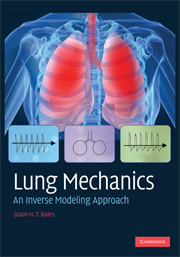Book contents
- Frontmatter
- Contents
- Preface
- Notation
- 1 Introduction
- 2 Collecting data
- 3 The linear single-compartment model
- 4 Resistance and elastance
- 5 Nonlinear single-compartment models
- 6 Flow limitation
- 7 Linear two-compartment models
- 8 The general linear model
- 9 Inverse models of lung impedance
- 10 Constant phase model of impedance
- 11 Nonlinear dynamic models
- 12 Epilogue
- References
- Index
Preface
Published online by Cambridge University Press: 05 June 2012
- Frontmatter
- Contents
- Preface
- Notation
- 1 Introduction
- 2 Collecting data
- 3 The linear single-compartment model
- 4 Resistance and elastance
- 5 Nonlinear single-compartment models
- 6 Flow limitation
- 7 Linear two-compartment models
- 8 The general linear model
- 9 Inverse models of lung impedance
- 10 Constant phase model of impedance
- 11 Nonlinear dynamic models
- 12 Epilogue
- References
- Index
Summary
Viewing the lungs as a mechanical system has intrigued engineers, physicists, and mathematicians for decades. Indeed, the field of lung mechanics is now mature and highly quantitative, making wide use of sophisticated mathematical and computational methods. Nevertheless, most books on lung mechanics are aimed primarily at physiologists and medical professionals, and are therefore somewhat lacking in the mathematical treatment necessary for a rigorous scientific introduction to the subject. This book attempts to fill that gap. Accordingly, some familiarity with the methods of applied mathematics, including basic calculus and differential equations, is assumed. The material covered is suitable for a first-year graduate course in bioengineering. I hope, however, it will also be accessible to motivated biologists and physiologists.
This book focuses on inverse models of lung mechanics, and is organized around the principle that these models can be arranged in a hierarchy of complexity. Chapter 1 expands on this concept and introduces the adjunct notion of forward modeling. It also sets the scene with a brief overview of pulmonary physiology in general. Chapter 2 attends to the fact that all the mathematical modeling skill in the world is for nought without good experimental data. Accordingly, this chapter is devoted to the key experimental methodologies that have provided the data on which the models described in subsequent chapters are based. It can thus be skipped without loss of continuity and referred back to when issues related to experimental validation of models arise.
Information
- Type
- Chapter
- Information
- Lung MechanicsAn Inverse Modeling Approach, pp. xi - xiiPublisher: Cambridge University PressPrint publication year: 2009
